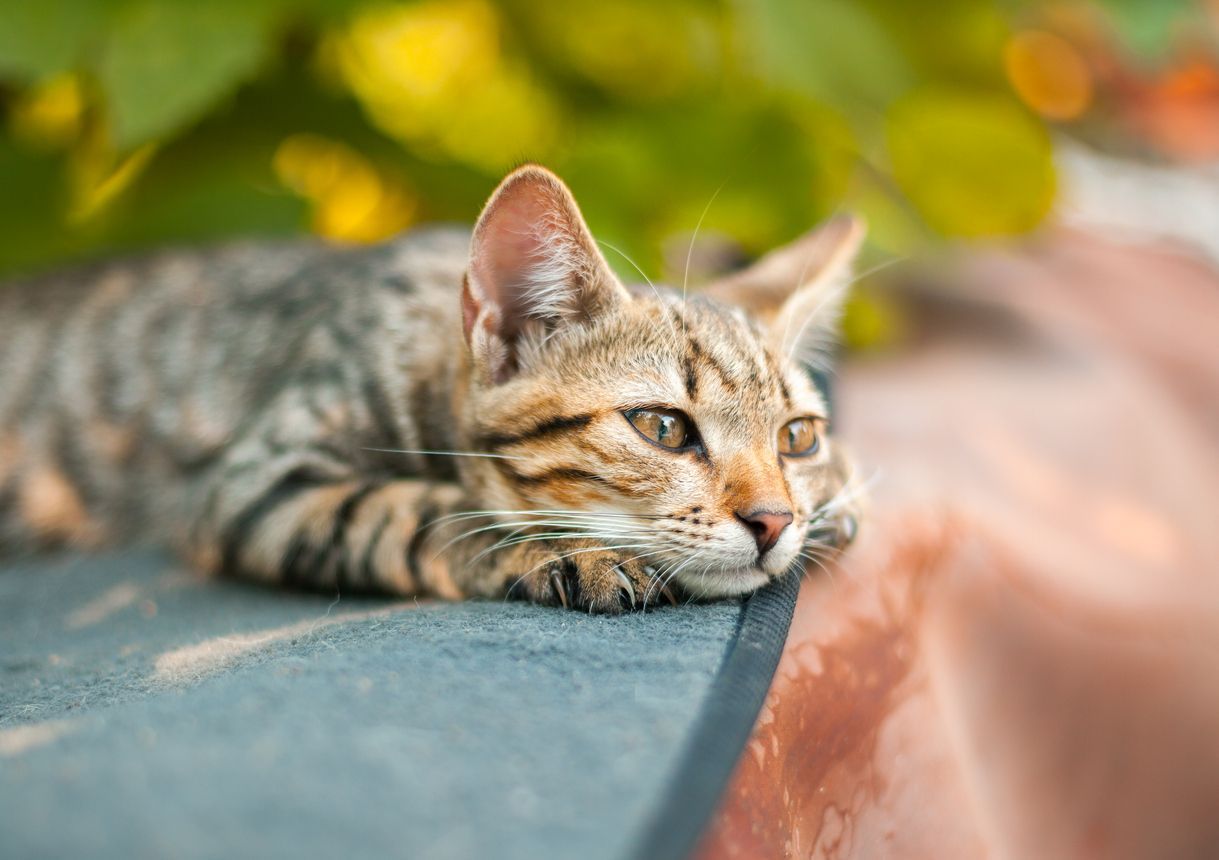Everything you need to know about pituitary gland disorders in cats

The pituitary gland, known as the “master gland,” regulates multiple essential bodily functions by releasing pituitary hormones and regulating other endocrine glands, such as the adrenal and thyroid glands. Clinical signs of pituitary gland issues can be vague and overlooked at first, so it’s important for cat owners to seek veterinary care if they notice changes in their pet’s physical or behavioral health. If you’re a cat owner, read on to discover:
- Why is the pituitary gland important?
- What conditions can a cat develop from a pituitary issue?
- What are the symptoms of pituitary disorders in cats?
- How are pituitary diseases in cats diagnosed and treated?
The pituitary gland secretes essential hormones, such as adrenal hormones and thyroid-stimulating hormones, that control various bodily functions, including metabolism, energy management, growth, and hydration. Common symptoms of pituitary issues include excessive thirst and urination, weight gain or loss, and lethargy. Pituitary gland disorders in cats are rare, so these symptoms are usually caused by another health issue.
What does the pituitary gland do?
A cat’s pituitary gland is a small endocrine gland, about the size of a small pea, located in the center of the brain. It has an essential role in regulating multiple essential hormones that control bodily functions and other endocrine glands. Because of its various functions, the pituitary gland is sometimes called the “master gland.” The pituitary gland is essential in regulating:
- Growth
- Energy management
- Metabolism
- Hydration and electrolyte balance in the kidneys and bloodstream
- Maturation and reproduction
- Pain relief
- Body temperature
The pituitary gland secretes hormones that stimulate the adrenal and thyroid glands, which control cortisol and thyroid hormone levels in the body; antidiuretic hormone (ADH), which is responsible for regulating urine production; and growth hormone and reproductive hormones, which are important for growth and development in cats.
What causes pituitary conditions?
There are multiple reasons why the pituitary gland may not work properly. The pituitary gland may be damaged due to:
- Pituitary tumors or tumors near the pituitary gland
- Traumatic brain injury
- Congenital pituitary defects
- Side effect of steroid medications
Tumors, brain injury, or pituitary defects are the most common causes of pituitary disorders in cats, but sometimes the underlying cause can’t be identified. When pituitary disease symptoms occur due to the use of steroid medications, the condition is usually temporary, and symptoms subside once the steroid dosage is adjusted or discontinued. Infections can potentially lead to pituitary disease, but this is very rare in cats.
What types of pituitary disorders can cats have?
There are multiple diseases that can occur when the pituitary gland is not functioning properly. The disorder will depend on which pituitary hormones are affected.
Cushing’s disease
Cushing’s disease, or Cushing’s syndrome, describes the results of increased cortisol levels in the bloodstream. The condition is very rare in cats and can be caused by a pituitary tumor causing increased production of adrenocorticotropic hormone (ACTH) that stimulates the adrenal glands to produce cortisol. Cushing’s disease can also develop due to malfunctioning adrenal glands or from steroid use. Senior cats are most at risk for Cushing’s disease, but the condition is rare in cats overall. The prognosis for Cushing’s disease varies based on its underlying cause and how well a cat responds to treatment.
Addison’s disease
Addison’s disease is a condition in which cortisol levels in the bloodstream are abnormally low. The condition is very rare in cats and is most often caused by brain tumors on or near the pituitary gland or the sudden discontinuation of steroid medications. It can also occur as a result of Cushing’s disease treatment. Addison’s disease has vague and intermittent clinical signs, making it difficult to diagnose until a life-threatening Addisonian crisis occurs. The disease is most common in senior cats but overall very rare. Prognosis depends on the underlying cause and ranges from poor to excellent with treatment.
Feline acromegaly
Acromegaly in cats is a disease caused by a pituitary tumor that leads to excessive growth hormone levels in the body. The tumor is usually benign, but some pituitary tumors can be cancerous. In some cases, feline acromegaly can be inherited. Acromegaly is uncommon in cats but may be underdiagnosed and may be responsible when cases of diabetes mellitus don’t respond well to treatment. A diagnosis of acromegaly is made most often in middle-aged to senior cats. Males seem to be at a slightly higher risk, and Maine Coons are disproportionately represented in studies compared to other cat breeds. The prognosis is variable depending on the underlying cause, and sometimes palliative care is the most humane approach.
Diabetes insipidus
Diabetes insipidus in cats is different from diabetes mellitus, or sugar diabetes. There are two possible causes for the condition: a lack of antidiuretic hormone (ADH) being created and secreted, or the kidneys not responding to ADH. Since ADH controls the kidneys' production of urine, the result of either cause is an overproduction of urine, leading to chronic dehydration and electrolyte imbalances. Diabetes insipidus may occur as a result of a problem in the brain (central diabetes insipidus) or a problem in the kidneys (nephrogenic diabetes insipidus).
Central diabetes insipidus can be caused by:
- Head injury
- Brain tumor
- Lymphoma
- Idiopathic (an unidentifiable cause)
Nephrogenic diabetes insipidus can be caused by:
- Acromegaly
- Medications, such as diuretics and glucocorticoids (e.g., prednisolone)
- Infections
- Liver disease
- Hyperthyroidism
- Congenital kidney defects
- Pyometra (infected uterus)
- Chronic renal insufficiency
- Idiopathic (an unidentifiable cause)
Diabetes insipidus is very rare in cats and should not be confused with diabetes mellitus. The prognosis varies based on the underlying cause, ranging from poor to good. In some cats, the disease can be successfully managed, and the cat can enjoy a good quality of life without medication as long as they have unlimited access to water and a place to urinate frequently.
Pituitary dwarfism
Pituitary dwarfism in cats is extremely rare and not well-documented. A lack of growth hormone from the pituitary gland in kittens leads to stunted growth that’s evident at a very young age. Pituitary dwarfism in cats is so rare that it’s not fully understood what causes it, though it’s suspected the causes in cats are similar to those in dogs with pituitary dwarfism, such as genetics and head trauma. Affected dogs can live relatively normal lives, so it’s thought that cats with pituitary dwarfism can as well, though some may have health issues.
Clinical signs of pituitary disorders in cats
Clinical signs of pituitary disorders in cats vary widely depending on the specific disorder. Signs may include:
- Increased thirst
- Excessive urination
- Unexplained weight gain or weight loss
- Hair loss
- Lethargy
- Vomiting or diarrhea
- Changes in behavior
- Abnormally large or small extremities and other body parts
Excessive thirst and urination are two of the most common clinical signs of pituitary disorders but also occur with many other health conditions unrelated to the pituitary gland. Pituitary disorders can lead to medical emergencies with symptoms such as:
- Pale gums
- Difficulty breathing
- Collapse
- Seizures or other neurological signs
It’s important to seek emergency care if any of these symptoms are present. They may or may not be caused by a pituitary disease.
How are pituitary gland issues diagnosed?
The diagnosis of a pituitary disorder begins with a physical exam and a list of presenting symptoms. Dwarfism or acromegaly may be suspected based on how a cat looks in a physical examination. Diagnostic testing may be recommended to aid in diagnosis and to rule out other conditions that may be causing the cat’s symptoms. Testing may include:
- Blood tests
- Urinalysis and urine culture
- Imaging, such as X-rays and ultrasounds
- Advanced imaging, such as MRI or CT scans to visualize the brain
Some pituitary disorders require specialized testing for a definitive diagnosis. These tests are not routine and increase the expenses associated with testing, so they aren’t usually the first step in diagnosing the underlying problem. A diagnosis is required for proper treatment of pituitary disorders.
How can a vet treat a cat’s pituitary disorder?
Treatment varies depending on the diagnosis and may include:
- Oral medication
- Insulin injections (as a palliative measure for cats with acromegaly)
- Chemo and radiation therapy
- Surgery
“Pituitary disorders are rare in cats, so treatment isn’t always well-defined or straightforward,” explains Dr. Jo Myers, a veterinarian on the Vetster platform. “Determining the best treatment plan for a cat with a pituitary disorder can be complicated. Sometimes, palliative care is the most humane option.”
Surgery on the pituitary gland is extremely difficult due to the gland’s small size and location in the brain. In addition, surgery is not always necessary because most pituitary tumors are non-cancerous and symptoms can be managed with medication. Medication dosages may require some trial and error because they’re not well established and each cat is different. Surgical removal of the pituitary gland is an extreme treatment and may result in serious side effects, so it’s not always a practical treatment option.
What should I do if I think my cat has a pituitary condition?
Always talk to a veterinarian if you notice changes in your cat’s physical or behavioral health. Many symptoms may seem minor and vague initially, often coming and going on their own. Excessive thirst and urination are very common symptoms of many diseases, including pituitary disorders. It’s important to seek veterinary help if your cat has been hit in the head, even if it seems minor. Injuries from getting hit by a door, accidentally kicked, or accidentally hit by sports equipment are common and may result in brain injuries that can lead to pituitary disorders.
Clinical signs of pituitary disorders are similar to other health conditions, so diagnostic testing is necessary to determine the best treatment plan. Routine wellness checks, especially for seniors, can help catch health issues, including pituitary conditions, before symptoms are obvious. Early detection often leads to better outcomes. If your cat is experiencing signs of a pituitary condition, or if you want to learn more about pituitary disorders, an online vet through the Vetster platform is available to answer your questions.
FAQ - Everything you need to know about pituitary gland disorders in cats
What are the symptoms of pituitary dwarfism in cats?
Pituitary dwarfism in cats results in stunted growth due to a lack of growth hormone, and the condition is apparent from a very young age. Pituitary dwarfism is very rare in cats, so it’s not well understood, but it’s assumed to be similar to the disorder that occurs in dogs.
What are the symptoms of a malfunctioning pituitary gland in cats?
Pituitary disorders have a wide variety of symptoms, depending on which hormone is affected. Symptoms may include changes in weight, excessive thirst and urination, changes to the skin and hair, lethargy, stunted growth, or abnormally large extremities and jaw.
Can pituitary tumors in cats be treated?
Pituitary tumors can sometimes be treated, but most are benign, and symptoms can be managed with medications. The pituitary gland is very small, located in the center of the brain, and regulates multiple essential hormones in the body. Damaging or removing the pituitary gland, even if there is a tumor, can have severe side effects.




